Flexible Workforce Development Fund (FWDF): evaluation
Independent evaluation of the Flexible Workforce Development Fund.
6. Employer Feedback
Summary
Almost all of the 203 employers surveyed in this evaluation consider workforce development to be important. A range of factors lie behind this, including to keep pace with change, to grow the business, to increase productivity/competitiveness, to address skills gaps, and the fact that people are the biggest asset an employer has.
Employer satisfaction with their engagement with the Flexible Workforce Development Fund (FWDF) is high. This includes aspects such as: time taken to assess applications and receive a decision; deadlines for applications; ease of finding out about the funding; and communication with the training provider. There have been strong levels of repeat business and relatively high levels of additionality.
The most common benefits reported by the 203 employers surveyed are:
- A more skilled workforce (92%).
- Increased knowledge and understanding of the colleges, The Open University in Scotland (OUiS) and independent training providers' offer (85%).
- Increased uptake of work-based learning provision (78%).
- Increased productivity (77%).
- Increased engagement with colleges and/or OUiS (76%), and an innovative, engaged and productive workforce (76%).
Almost all employers would recommend the FWDF to other employers, and almost all said they would apply to the FWDF in future years (at the time of the evaluation, a blended model of delivery is the preference).
More negative feedback needs to be viewed in the context of high levels of positive feedback and ratings overall. There was most disagreement with statements relating to "training content being developed from scratch to meet our needs, etc.", and there does appear to be some potential employer demand for this.
The ability to use multiple training providers could also provide greater flexibility for employers. Some employers consider the application process and registration of employees on training courses burdensome, with feedback that timescales for submitting applications and for the training to start/complete do not meet employers' needs.
While a majority of employers consider the funding cap appropriate, Levy-payer employers are more likely to disagree.
Introduction
A sample of 800 employer contacts was developed from the population of employers supported drawn from the raw data provided by colleges/OUiS via the Scottish Funding Council (SFC) and from Skills Development Scotland (SDS). An introductory letter prepared by EKOS and the Scottish Government was issued by colleges, OUiS, and SDS to their share of contacts. Participation in the telephone survey was entirely voluntary and particpants could withdraw at any time.
A total of 203 employer telephone interviews were undertaken by Research Resource:
- 93% of these employers are supported via the SFC route. The remainder received a grant from SDS (7%).
- 79% are Levy-payer employers. The remainder are non-Levy-payer Small and Medium Enterprises (SMEs) (21%)..
Employer views on workforce development
This sub-section is about workforce development. We present employers views on the FWDF in the following sub-sections.
Almost all of the 203 employers surveyed (99%) either agreed (10%) or strongly agreed (89%) that workforce development is very important to their business. Reasons provided by employers include:
- To help meet the pace of change and to stay relevant.
- That people are the biggest asset a business has.
- To support increased productivity, competitiveness, and business growth.
- A skilled workforce can also support: skills gaps to be addressed, a more efficient and motivated workforce, employees to feel valued, employees to progress internally within the business, development of cross-functional teams/transferable skills, improved customer service, and succession planning.
- A commitment to workforce development helps to attract/retain staff. Some employers highlight current challenges in relation to staff turnover, recruitment and staff shortages, as well as post EU-exit challenges.
- To address the challenges presented by an ageing workforce.
Most of the 203 employers who took part in the evaluation reported undertaking workforce development (94% provide internal training 97% arrange external training delivered by a third party).
Engagement with the FWDF
Employers heard about the FWDF in many ways, most notably through the college network, Figure 6.1.
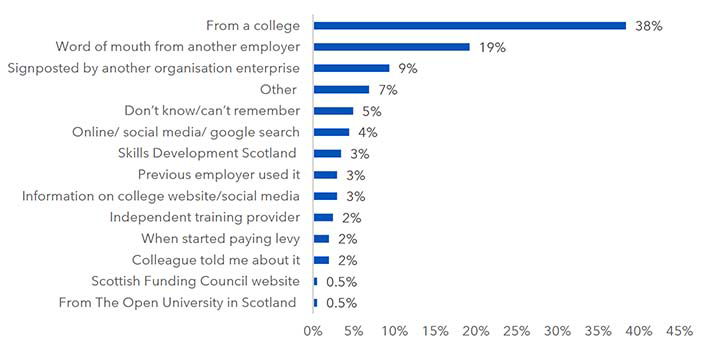
Source: EKOS FWDF evaluation employer telephone survey delivered by Research Resource as part of this project.
Base: Number of employers surveyed was 203.
Note: 'Other' responses reported for this question included 'from a university contact' and 'from previous employment'.
Skills gaps
Prior to applying to the FWDF, most employers surveyed (178) report that they had a skills gap(s) in their business (88%). The main skills gaps are Leadership and Management, IT and Digital, Coaching and Mentoring skills, and Health and Safety. Delivery partners note that these skills gaps should be taken as snapshot in time, during the pandemic. COVID-19 made a big change in skills gaps which may normalise quite quickly.
Satisfaction with FWDF processes
In general, employers (n=203) are satisfied with their engagement with the FWDF, Table 6.1. The highest levels of satisfaction are reported for:
- Time taken to assess applications and receive a decision (89%).
- Deadlines for applying (88%).
- Ease of finding out about the funding (85%).
- Communication with the training provider (85%).
Employers are particularly keen to draw attention to the simplicity of the application process, the speed with which they received a response to their application, and most importantly, the good levels of communication with their training provider.
| Satisfied/ very satisfied | Neither satisfied nor dissatisfied | Dissatisfied/ very dissatisfied | |
|---|---|---|---|
| Time taken to assess applications/receive decision | 89% | 5% | 4% |
| Deadlines for submitting an application | 88% | 7% | 4% |
| Communication with the training provider | 85% | 12% | 3% |
| Ease of finding out about the funding | 85% | 6% | 8% |
| Clarity of the guidance issued | 84% | 11% | 4% |
| Time taken to agree and deliver training | 83% | 12% | 4% |
| Maximum amount of funding available per annum/year | 83% | 7% | 10% |
| Clarity regarding what training was eligible | 82% | 12% | 5% |
| Ease of the application process | 78% | 13% | 7% |
| Time taken to receive grant payment(s) | 67% | 0% | 7% |
| Training needs analysis undertaken | 66% | 9% | 4% |
Source: EKOS FWDF evaluation employer survey
Base: Number of employers = 203 for all except 'Time taken to receive grant payments', N=15 (SDS route).
Note: Not applicable response options were excluded, so some options do not equal 100%. For example, not all employers received a grant or had a training needs analysis undertaken (e.g. SDS route).
Level of engagement with the FWDF
Employers surveyed were supported across multiple rounds of the FWDF. Over two-thirds (69%) of the 203 employers surveyed have accessed the FWDF on more than one occasion, and there has been strong levels of repeat business.
Training supported by the FWDF
Key points to note from the feedback of 203 employers include:
- Most employers used a college – 89% of Levy-payer employers and 81% of non-Levy-payer SMEs. Employers surveyed have used the FWDF support for training courses at 23 of 27 colleges in Scotland, albeit to varying degrees.
- Fewer employers used OUiS or the SDS route – this reflects the length of time these elements have been operational.
- Almost one-fifth of non-levy-payer SMEs used OUiS:
- Wider feedback on the use of OUiS highlights: a positive prior experience; the wide range/variety of courses available; flexibility of online learning alongside employment; course/qualification met employers and employees needs; suits employers with a geographically dispersed workforce.
- 13% of Levy-payer employers used an independent training provider:
- A range of sectors were supported, including Energy (including renewables), Business Services, and Oil and Gas.
- These employers sought Leadership and Management, and IT and Digital, and Coaching and Mentoring training.
- Most of these employers report that they found it easy or very easy to identify an independent training provider (86%). The remainder report "neither easy nor difficult" (14%).
Table 6.2: Which type of training provider has/will deliver the FWDF training?
| Levy-payer employer | Non-Levy-payer SME | |
|---|---|---|
| College | 89% | 81% |
| OUiS | Not applicable | 19% |
| Independent training provider | 13% | Not applicable |
Source: EKOS FWDF evaluation employer survey undertaken as part of this study.
Base: Employer number = 161 (Levy-Payer employer), 42 (Non-Levy-Payer SME).
Multiple response question where employers could select more than one option and all that applied. Percentages may total more than 100% as a result.
81% of the 203 employers surveyed have only used a single training provider. For many this worked well due to factors such as:
- Existing and good working relationship with the training provider.
- The range and quality of training available met employers' needs (e.g. no requirement to look elsewhere, good experience, quality training, tailored, positive feedback from employees).
- The college was able to arrange for other providers to deliver elements of the training if they were not able to do so.
- Quicker, easier, and more manageable to coordinate all of the training.
- Good value for money.
- The training provider has been flexible and accommodating.
Some of the employers responding note, however, that they were not aware that they could use more than one training provider if accessing the SDS delivery route. It is suggested that this could provide "greater flexibility".
The remainder of employers used multiple providers (19%). Where this was the case, the main points raised by employers are that:
- FWDF guidance is to use a college in the first instance. Not all training needs can be addressed by a single training provider. Some employers refer to accessing more specialist training from a private sector provider as a result.
- Some employers mention that the college sub-contracted or out-sourced elements of the training out to other providers.
- They could access new or a wider range of training and/or improve training availability.
- They could get better value for money.
- Some colleges are more "forward thinking", and tailor training appropriately.
- They used another training provider due to a "bad experience" with another.
A wide range of training courses have been undertaken by the 203 employers surveyed. Leadership and Management training is the most popular (59%), followed by IT and Digital (42%), Health and Safety (35%), and Coaching and Mentoring (31%). These match the skills gaps reported earlier by employers.
Views on the training and training providers
- Employers are overwhelmingly positive about the time, duration, provision, specificity, impact, and quality of the courses.
- The highest levels of "agreement" (i.e. agreed or strongly agreed) are reported for the following statements (Base: 203 employers):
- The training provider was professional, responsive, and approachable (93%).
- Duration of the course (91%).
- Training has met our business needs (90%).
- Training has helped/will help address our skills gaps (89%).
- Mode of delivery was appropriate and suited our needs (89%).
- At the time of the evaluation, employers also appear to hold more positive attitudes towards online learning since the pandemic (87%) (Base: 203 employers). This finding, however, may change over time.
- Most "disagreement" (i.e. disagreed or strongly disagreed) with the statements are those relating to the degree of tailoring in course design (Base: 203 employers):
- They devised the training content from scratch to meet our needs (42%).
- We were involved in determining the design and/or content of the training (18%).
- They were willing/able to tailor an existing training course to better meet our needs (17%).
It should be noted that colleges (and now OUiS) have not received any funding through the FWDF (until Year 5) to develop new training content in response to employer demand. The findings do, however, suggest that there may be demand for more bespoke training offers, albeit this may be constrained by a range of factors, including identifying scale and nature of demand, training provider capacity, and time to develop bespoke training.
Around one-third of employers do not point to any specific areas for improvement in the training (circa 33% of 203 employers). Here, there are a variety of comments such as: "Nothing", "No because I ended up with a trainer who could understand the culture of the organisation. It was responsive"; "No. It met the needs we had"; "No issues, all the feedback was great".
Where mentioned, some employers do note that there could be improvements regarding training content, with several noting it is too generic or that lecturers lack detailed knowledge of their industry/sector. Additionally, some employers report the need for greater flexibility regarding when the training is delivered, the timescales for the training to be delivered, and/or course duration.
Funding cap
Almost two-thirds of employers responding to the survey report that the level of funding provided by the FWDF is appropriate for the purposes of training their employees (63%), Figure 6.2. Levy-payer employers are less likely than non-Levy-payer SMEs to agree with the statement.
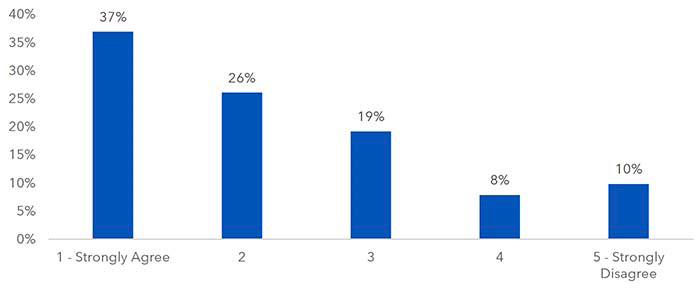
Source: EKOS FWDF evaluation employer survey. Base: employer number = 203.
Where the funding cap is considered appropriate, the feedback largely focusses on the following themes. Non-Levy-payer SMEs note that the £5,000 can purchase a lot of training and that it is a "sizeable" amount of funding. Wider feedback identifies constraints to undertaking workforce development (e.g. time away from the business), and that the bite-size training available via the FWDF sits comfortably with smaller employers.
Other employers note that the funding cap is "fair" or "reasonable". Some employers acknowledge the total funding pot available and understand the rationale behind the annual funding cap. Further, it is reported that the funding cap helps employers to identify what training they really need or what part of the business needs it most – and that they have been able to select various types of courses.
In terms of the £15,000 funding cap, there are two broad views:
- Some employers struggle to identify training up to the full amount of £15,000, and/or consider it a "sufficient", "just right" "workable", "substantial" or a "generous" amount of investment. Wider feedback is that the funding cap is in line with the cost of the courses, and that it enables employers to undertake training that would otherwise not have been possible.
- Other employers would welcome a greater level of funding (e.g. to undertake more training, to put more staff on courses, to select certain courses/types of training, etc) – "a drop in the ocean", "spread too thinly", "don't get much back" from the Apprenticeship Levy – or at least be able to carry forward funding from one year to another. A suggestion is for a funding scale in line with the size of employer or how much is paid into the Apprenticeship Levy.
Employees supported by the training
Formal qualifications
Most of the training undertaken/to be undertaken through the FWDF was said by the 203 employers to result in a qualification for some to all employees who took part/will take part in the training (88%).
Equalities
A key finding is that a vast majority of employers report that some employees that took/will take part in the training supported by the FWDF were women, older workers, and/or younger workers. Less employers, however, report that employees were minority ethnic or disabled workers, Figure 6.3.
Further, in terms of proportions of employees that have taken part in the training, women appear to be the most well represented across the different equalities groups.
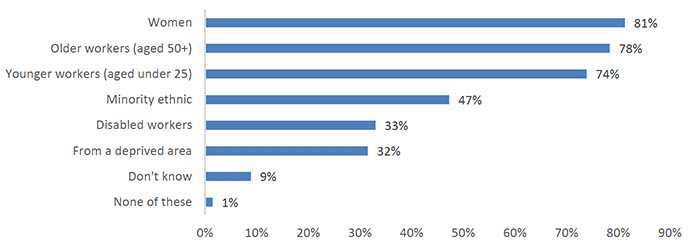
Source: EKOS FWDF evaluation employer survey
Base: employer number = 203.
Multiple response question where employers could select more than one option and all that applied. Percentages may total more than 100% as a result.
Impact of COVID-19
Almost three-quarters of the 203 employers report that COVID-19 has impacted their training in some way (71%). A range of factors are identified, most commonly that their staff could not take part when originally planned and that the training provider also faced challenges in delivery.
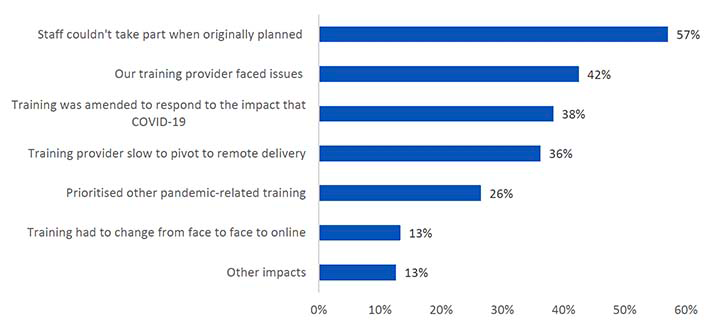
Source: EKOS FWDF evaluation employer telephone survey undertaken by Research Resource.
Base for question: employer respondents number = 144.
Multiple response question where employers could select more than one option and all that applied. Percentages may total more than 100% as a result.
Benefits and impacts
The employer benefits (achieved to date or expected to achieve over the next year) are strongly aligned to the main purpose of the FWDF. Top benefits reported by employers in this evaluation are:
Figure 6.5: Employer benefits
- A more skilled workforce: (92%)
- Increased productivity: (77%)
- Increased engagement with colleges and/or OUiS: (76%)
- An innovative, engaged and productive workforce: (76%)
Source: EKOS FWDF evaluation employer telephone survey undertaken by Research Resource.
Base: employer number = 203 which was the total number of respondents to the survey.
Multiple response question where employers could select more than one option and all that applied. Percentages may total more than 100% as a result.
Figure 6.6: Employee benefits
- Increased skills levels: (89%)
- Experienced more fulfilling work: (72%)
- Increased level of qualifications: (70%)
Source: EKOS FWDF evaluation employer telephone survey undertaken by Research Resource.
Base: Employer number = 203. 203 employers was the total number of respondents to the survey.
Multiple response question where employers could select more than one option and all that applied. Percentages may total more than 100% as a result.
Figure 6.7: Employer and training provider benefits
- Increased knowledge of the training provider offer: (85%)
- Increased uptake of workbased learning provison: (78%)
- Colleges and OUiS provide increased provision for employers: (72%)
Source: EKOS FWDF evaluation employer telephone survey by Research Resource as part of this project. Base: employer number = 203. A total of 203 employers took part in the survey.
Multiple response question where employers could select more than one option and all that applied. Percentages may total more than 100% as a result.
Where unexpected outcomes are reported (not to any greater extent) by employers, this largely includes less positive points, such as:
- Tutor turnover and the impact that this had on delivery of training and communication with employers.
- That training was not pitched at right level, or not as appropriate or as relevant it could have been.
- Time commitments and levels of bureaucracy involved, including for smaller companies.
- That college delivery of training is restricted to term-time and/or that the default position is that a college is the training provider.
- Initial problems with online delivery and learning.
Tackling inequality
While many employers report in the survery responses that equalities groups (e.g. women) have participated in FWDF related training (as outlined above), views are more mixed regarding the extent to which the Fund helps employers to tackle inequality and support those with protected characteristics in any way, Figure 6.8.
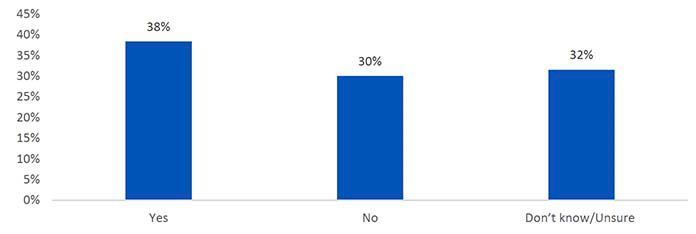
Source: EKOS FWDF evaluation employer telephone survey undertaken by Research Resource as part of the project .
Base: employer number = 203. The total number of employers responding to the survey was 203.
Where employers feel that the Fund helps to tackle inequality, the main points raised are that:
- The FWDF allows employers to expand training opportunities to more employees. A point raised, however, is that companies/organisations invest in their "workforce" as a whole ("equal opportunity employer"), rather than specific target groups. It was perceived that employees within the equalities groups would have naturally participated in the training as a matter of course.
- It supports companies/organisations to provide a better service to client groups that face inequality, including those with protected characteristics.
- The FWDF supports older employees to become more digitally literate.
- The FWDF supports junior and younger employees to develop softer skills.
- For some companies/organisations, gender balance in the workforce is identified as an area of particular focus, and the FWDF enables employers to encourage female employees to participate in the training.
- The FWDF supports employees to increase their understanding of mental health and wellbeing in the workforce, and this has become even more important because of the pandemic.
Where employers feel that the Fund has not helped to tackle inequality:
- Employees with protected characteristics would have participated in the training as a matter of course, and that there is not a conscious effort on this.
- Tackling inequality is not employers' understanding of the main purpose or aim of the Fund. In this regard some said it is not relevant or does not apply. Any inequalities that exist within the workforce are identified and addressed internally, and not through vehicles for training such as the FWDF.
Follow-on activity
A positive finding from the survey is that that 38% of the 203 employers report that engagement with the FWDF has led to follow-on activity with the training provider, and a similar proportion said this is likely in the future (36%). Only 12% said this was unlikely. In the main this has/will centre on further workforce development activity, Figure 6.9.
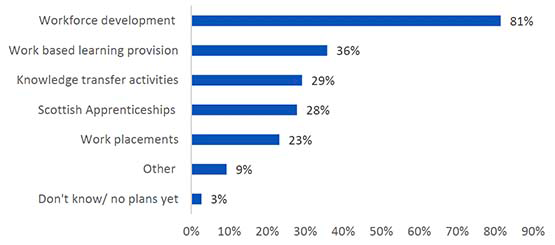
Source: EKOS FWDF evaluation employer telephone survey undertaken by Research Resource.
Base: employer number = 151. The total number of respondents to the survey was 203.
Multiple response question where employers could select more than one option and all that applied. Percentages may total more than 100% as a result.
Additionality of the FWDF investment
The survey of 203 employers shows relatively high levels of additionality:
- Almost three-quarters would either not have undertaken any of the training or only have undertaken some or half of it (73%). Wider feedback highlights choices would have been made, with mandatory or essential training likely to have taken priority in the absence of the FWDF. Where an element of the training could have progressed, some employers point to trying to accommodate this internally.
- Only 14% would have undertaken the training anyway or would have progressed most of it in the absence of the FWDF. Much of the feedback notes that the FWDF allowed the training to happen sooner. Without the FWDF the training would have likely been delayed and/or deferred to a later date. Some employers said they would have paid for the training themselves.
- The remainder of employers would have deferred the training.
Table 6.3: What would have happened to the training undertaken if the FWDF had not been available?
| Number | Percentage (%) | |
|---|---|---|
| We would have undertaken all the training anyway | 17 | 8% |
| We would have undertaken most of the training | 13 | 6% |
| We would have undertaken around half of the training | 20 | 10% |
| We would have undertaken some of the training | 83 | 41% |
| We would have had to defer the training and deliver it at some other time | 25 | 12% |
| We would not have undertaken any of the training | 45 | 22% |
Source: EKOS FWDF evaluation employer telephone survey undertaken by Research Resource as part of this project.
Base: employer number = 203. Total number of employers responding was 203.
Over half of the 203 employers report that the FWDF enables the business to undertake additional workforce development training than they previously planned to undertake (58%), and a further 8% report this is "maybe" the case. A relatively large proportion of employers are, however, unsure or report that the FWDF has not enabled them to undertake additional workforce development training.
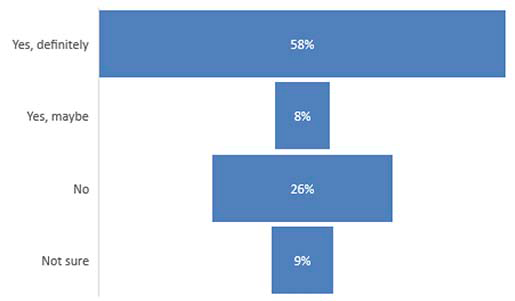
Source: EKOS FWDF evaluation employer telephone survey delivered by Research Resource as part of this project.
Base: employer number = 203. Total number of employers responding to this survey was 203.
Recommend FWDF to other employers
A positive finding coming from the survey of employers is that most employers would recommend the FWDF to other employers (95% rate this likely or very likely, with most reporting very likely), Figure 6.11.
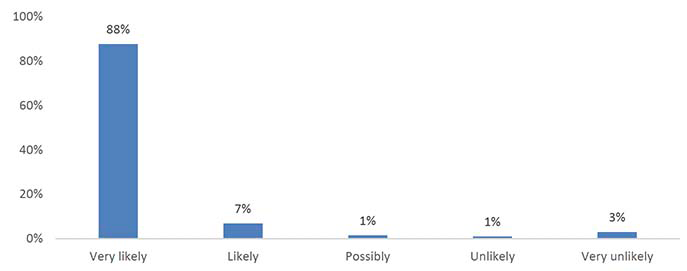
Source: EKOS FWDF evaluation employer telephone survey delivered by Research Resource as part of the project.
Base: employer number = 203. 203 employers in total participated in the survey.
Applying to the FWDF in the future
Further, a similar proportion of employers said they would apply to the FWDF in the future (95% rate likely or very likely), Figure 6.12. This is a further testimony of the high levels of satisfaction expressed by employers with the Fund.
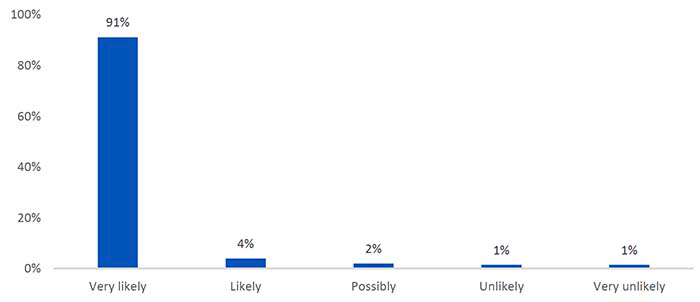
Source: EKOS FWDF evaluation employer telephone survey delivered by Research Resource.
Base: employer number = 203. Total number of employers participating was 203.
Of note, 80% of the 203 employers report that they would prefer a blended model of delivery (i.e. face-to-face and remote/online) going forward.
While there are said to be "pros and cons" associated with different modes of delivery, the main reasons put forward by employers for a blended approach include:
- The type of course to be undertaken. Some courses lend themselves well to (or need to be delivered) in person, while for others this is less of an issue.
- A blended approach provides more options and/or greater flexibility for employers and employees (e.g. for those located in remote or island communities).
- The option for online training/learning can work well for those who want to work at their own pace, who want to have less time away from the office, or balance training and work/other commitments.
- In-person delivery is better for sharing experiences and for formal and informal networking and collaboration.
Key points to note from the survey of 203 employers on current skills gaps include:
- Most employers report a current skills gap(s) – 93%.
- The main skills gaps continue to be: Leadership and Management, IT and Digital, and Coaching and Mentoring. These typically reflect the skills gaps identified earlier by employers.
- Relatively equal proportions of employers report that the COVID-19 pandemic has made the skills gaps more pronounced (47%) as those who reported that the pandemic has not exacerbated these skills challenges (42%).
The main drivers of change identified by employers within their industry sector that might cause skills/labour problems are keeping pace with changing customer expectations, digital innovation and COVID-19 recovery, Figure 6.13. The climate emergency is lower down the list of drivers of change noted by employers.
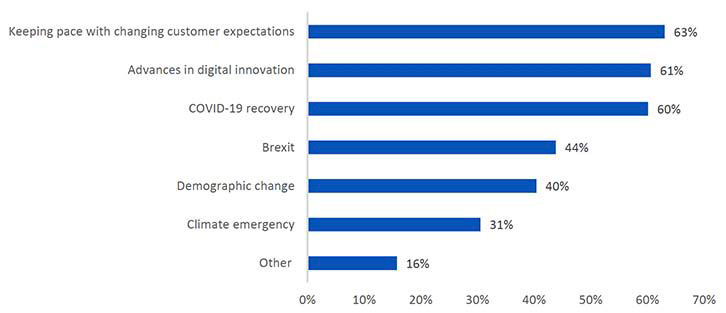
Source: EKOS FWDF evaluation employer telephone survey delivered by Research Resource as part of this project
Base: employer number = 203. Total number of employers participating in the survey was 203.
Multiple response question where employers could select more than one option and all that applied. Percentages may total more than 100% as a result.
'Other' category, for example included: job/career mobility; staff attraction, recruitment and retention; cost of living crisis; rising inflation; increasing costs of goods/services/materials; war in Ukraine.
Final thoughts
The main points raised by employers in relation to their views and experiences of what has worked well and less well with the FWDF are highlighted below. Indeed, many of the points outlined have been reflected elsewhere throughout the employer survey write-up. It should be noted that similar points are raised in both the worked well and less well sections, and this simply reflects employers different experiences of the Fund.
What works well with the FWDF
- Targeted support for workforce development.
- A Fund that can be applied for each year.
- Access to financial support.
- Flexibility and responsiveness of the Fund.
- Helps employers think about/address skills gaps.
- Range/variety of courses that meets employer needs.
- Access to quality training. Tailoring provision or developing bespoke training.
- It benefits both employers and employees.
- Ability to provide wider training opportunities for staff (i.e. not mandatory or essential training).
- Builds and strengthen employer relationships with training providers.
- Straightforward and smooth application process (i.e. ease of access to the FWDF).
- Good communication with training providers.
- Training providers are approachable, friendly, professional, supportive, etc.
- Access to remote learning (reduces travel time).
- Colleges can help co-ordinate provision from other training providers where necessary.
What works less well with the FWDF
Many employers reported "nothing" in relation to what works less well with the FWDF. Where points were raised, this mainly included:
- Administrative burden.
- Academic years, FWDF timescales, and year-on-year funding does not always meet employers needs.
- There could be more information on the range of courses available.
- Limited choice in training provider (e.g. could open this up to using multiple providers).
- Communication from the training provider at times could have been improved.
- Training is not as tailored or as bespoke as some employers would prefer (i.e. it is off-the-shelf).
- Lack of clarity on which training providers employers can and cannot use.
- Employer knowledge of how to access independent training providers (and time taken to organise this provision).
Contact
Email: richard.dryburgh@gov.scot
There is a problem
Thanks for your feedback